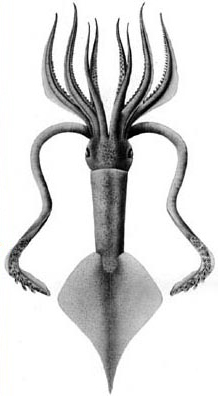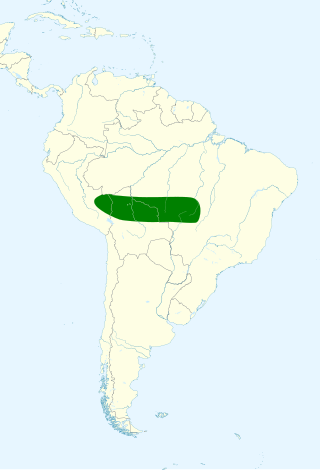
Brachioteuthis is a genus of squid comprising six species.

Psychroteuthis glacialis, the glacial squid, is the only known species in the monotypic genus Psychroteuthis, in the family Psychroteuthidae. While only one species has been confirmed, two undescribed species also probably exist. The species occurs in coastal waters near Antarctica and South America. It grows to a mantle length of 44 cm (1.44 ft).
Brachioteuthidae is a family of squid containing two genera and around seven species.

Onykia robusta, also known as the robust clubhook squid and often cited by the older name Moroteuthis robusta, is a species of squid in the family Onychoteuthidae. Reaching a mantle length of 2 m (6.6 ft), it is the largest member of its family and one of the largest of all cephalopods. The tentacular clubs are slender, containing 15–18 club hooks. Arms of the species contain 50–60 suckers, and grow to 90–100% of the mantle length. It is found primarily in the boreal to Temperate Northern Pacific.

Ancistroteuthis lichtensteinii, also known as the angel clubhook squid or simply angel squid, is a species of squid in the family Onychoteuthidae and the sole member of the genus Ancistroteuthis. It grows to a mantle length of 30 cm. It lives in the western Mediterranean Sea, subtropical and tropical eastern Atlantic Ocean and western north Atlantic Ocean. Its diet include mesopelagic fish and pelagic crustaceans. It is sometimes taken as bycatch by commercial fisheries, but is not a targeted species.

Onychoteuthis banksii, the common clubhook squid, is a species of squid in the family Onychoteuthidae. It is the type species of the genus Onychoteuthis. This species was thought to have a worldwide distribution but with the revision of the genus Onychoteuthis in 2010, it is now accepted that Onychoteuthis banksii is restricted to the central and northern Atlantic and the Gulf of Mexico while a recently described species, Onychoteuthis horstkottei, is found in the Pacific Ocean. The type locality is the Gulf of Guinea.
Moroteuthopsis longimana, also known as the giant warty squid or longarm octopus squid, is a large species of hooked squid. It attains a mantle length of at least 85 cm and probably over 1.15 m. The largest complete specimen of this species, measuring 2.3 m in total length, was found in Antarctica in 2000.

Behn's bat, Behn's big-eared bat, or Behn's graybeard bat is a species of bat in the family Phyllostomidae found in Brazil and Peru. It is known only from six specimens and is considered rare. It feeds on insects and small fruits.

The Japanese flying squid, Japanese common squid or Pacific flying squid, scientific name Todarodes pacificus, is a squid of the family Ommastrephidae. This animal lives in the northern Pacific Ocean, in the area surrounding Japan, along the entire coast of China up to Russia, then spreading across the Bering Strait east towards the southern coast of Alaska and Canada. They tend to cluster around the central region of Vietnam.
Filippovia knipovitchi, the smooth hooked squid, is a species of squid in the family Onychoteuthidae and the sole member of the genus Filippovia. It is found in the Antarctic and Atlantic Oceans, and reaches a mantle length of 35 cm.
Onykia loennbergii, the Japanese hooked squid, is a species of squid in the family Onychoteuthidae, named by Swedish zoologist Einar Lönnberg. It occurs in the Western Pacific Ocean, at an estimated depth of 230–1200 m. The mantle length is approximately 300 mm. Each tentacular club contains 25 hooks. The arms are about 60% of the size of the mantle length.

Onykia robsoni, the rugose hooked squid, is a species of squid in the family Onychoteuthidae. It occurs in the Antarctic Ocean, at an estimated depth of 250–550 meters. The mantle of this species grows to a length of 75 cm. The species has been suggested as a junior synonym of Onykia carriboea, the tropical clubhook squid, due to similarities between the species.

Onychoteuthis borealijaponica, the boreal clubhook squid, is a species of squid in the family Onychoteuthidae. It is the largest member of the genus Onychoteuthis, reaching a mantle length of 30 cm in males and 37 cm in females. Maturity is reached at 250 mm for males, and 300–350 mm in females. There are 24–27 hooks on each club, which is more than any other species in the genus Onychoteuthis. It is a pelagic species native to the North Pacific, although it migrates into Subarctic waters during the summer from its more southerly winter spawning grounds.
Notonykia africanae is a species of squid in the family Onychoteuthidae. It is the type species of the genus Notonykia. While the mature size of the species is unknown, it is known to reach a mantle length of at least 180 mm. Tentacles reach approximately 70% of the mantle length, and contain 14-20 club hooks. Arms are known to reach 27-45% and 33-55% of the mantle length; each containing 50-60 suckers. The species is located in southern waters off Australia, Tasmania, New Zealand and South Africa.

Pterygioteuthis gemmata is a species of squid in the family Pyroteuthidae.

The colossal squid is the largest member of its family Cranchiidae, the cockatoo or glass squids, with its second largest member being Megalocranchia fisheri. It is sometimes called the Antarctic cranch squid or giant squid and is believed to be the largest squid species in terms of mass. It is the only recognized member of the genus Mesonychoteuthis and is known from only a small number of specimens. The species is confirmed to reach a mass of at least 495 kilograms (1,091 lb), though the largest specimens—known only from beaks found in sperm whale stomachs—may perhaps weigh as much as 600–700 kilograms (1,300–1,500 lb), making it the largest known invertebrate. Maximum total length has been estimated between 10 metres (33 ft) and 14 metres (46 ft) but the former estimate is more likely. The colossal squid has the largest eyes of any known creature ever to exist, with an estimated diameter of 27–30 cm (11–12 in) to 40 cm (16 in) for the largest collected specimen.

Nototodarus sloanii is a species of squid commonly known as the New Zealand arrow squid or Wellington flying squid. It is also known by its Māori name of wheketere. It is a favoured prey species of a number of marine mammals and diving birds. It is an important food source for the New Zealand fur seal and two endangered species: the New Zealand sea lion and the yellow-eyed penguin. N. sloanii is sought by trawler fishermen for human consumption; New Zealand sea lions are frequently caught in trawl nets and drowned when feeding on N. sloanii.
Brachioteuthis riisei is a species of squid in the family Brachioteuthidae.

The purpleback flying squid or purpleback squid is a species of cephalopod in the family Ommastrephidae, occurring in the Indo-Pacific. It is considered one of the most abundant large squids.

Brachioteuthis beanii is a species of squid in the family Brachioteuthidae that lives in pelagic environments. Its young are 1.2 mm (0.047 in) in length.














